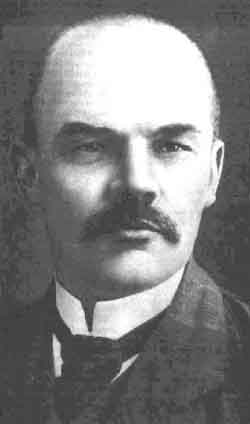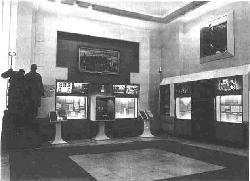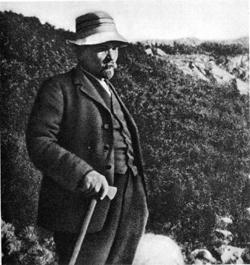A New Rise of the Revolutionary Tide (1910-1914)
V.I.Lenin, 1910.
The central display in this room is dedicated to the documents of the 6th All-Russia Conference of the RSDLP held in Prague in January 1912. The important work of this Conference was purging the Party of opportunists. Its entire work took place under Lenin's immediate direction. He was elected conference chairman and gave speeches and reports on the most important questions. He prepared draft resolutions which as a result became the conference's decisions. Lenin's tremendous work in the preparation and carrying out of the Prague Conference is demonstrated in this room's exposition: his manuscripts of draft resolutions, the actual resolutions and articles in preparation for the conference are shown in the display cases and stands. Located here are the photographs of the Central Committee elected at the Conference and headed by Lenin, and a model of the room in the People's House in Prague where the Conference took place. Evaluating the Prague Conference Lenin wrote: "For over two years, since 1912, there has been no factionalism among the organised Marxists in Russia, no disputes over tactics in united organisations, at united conferences and congresses." The artist A. Moravov's painting, "The Lena Shooting" is displayed here. This tragic event took place in April 1912 in the gold-fields on the river Lena in Eastern Siberia. Tsarist troops shot down unarmed workers conducting a peaceful economic strike. This went down in Russian history as the "Lena Shooting". It was a strong stimulus for a steep revolutionary upsurge throughout Russia. More than 300,000 workers participated in strikes of protest against the cruel massacre of the workers on the Lena, and almost a half million people took part in the May Day demonstrations. It was during these days close to April 22 (May 5) that the first issue of the daily Bolshevik newspaper Pravda (Truth) appeared. Since that day. May 5 has been celebrated in the Soviet Union as a holiday of the workers' press-Press Day. The materials on exhibition demonstrate Lenin's active role in Pravda. His articles and notices regularly appeared on its pages. Lenin exposed the anti-popular policy of tsarism and the bourgeoisie with simple, convincing examples in a form understandable to workers, and set important political tasks before his readers.
"The Workers Reading Pravda" (by artists R. Taurit and V. Isayeva).Pravda was published with the workers' money and enjoyed their trust and love. The workers took up 620 group collections for their newspaper in 1912, 2181 in 1913, and 2873 from January to May 1914. The popularity of the Bolshevik newspaper among the workers is conveyed by the sculpture, "The Workers Reading Pravda" (by artists R. Taurit and V. Isayeva). In June 1912 V.I. Lenin and N.K. Krupskaya moved from Paris to the ancient Polish city of Cracow. The numerous articles, notices and letters located in the exhibition show how from Cracow Lenin guided the newspaper Pravda and the activities of the Party organisations in Russia. In this hall there are photographs with views of Prague, Cracow, Bialy Dunajec, Poronin, etc. V. I. Lenin lived in these places. Here, for example, is Cracow, where at the end of December 1912, a meeting of the Central Committee and Party workers who had come illegally from Russia took place in Lenin's apartment. Here is Poronin. In this village, close to the famous mountain resort Zakopane, V.I.Lenin, N. K. Krupskaya and her mother spent two summers in 1913 and 1914 trying to improve N. K. Krupskaya's health. (see Krupskaya's article about Lenin at the Defend Lenin mausoleum! site)
Lenin in emigration. Poland. 1914....In the morning Lenin would swim in the Dunajec, little mountain river, before breakfast. Then he would drop in to the post office, receive his correspondence, and quickly glance through it in order to answer urgent telegrams and letters on the spot. After breakfast he would sit down to work which lasted until 7:00 in the evening with one short break. Then he would take his mail to the train station on bicycle. In nice weather Lenin would take his work and climb up to the hill Galitsova Grapa. A splendid view of the Tatry Mountains could be seen from there. V.I.Lenin's works, "Critical Rem arks on the National Question" and "The Right of Nations to Self-Determination", occupy a prominent place in the exposition. In these works he developed a Marxist programme on the nationalities question, elucidated the nationalities policy of the Party, which was of particular importance in the years of revolutionary upsurge because imperialism was intensifying national oppression and arousing national hatred. Lenin severely criticised the views of Russian and foreign opportunists, exposed bourgeois nationalism and showed the great significance of proletarian internationalism. "Complete equality of rights for all nations; the right of nations to self-determination; the unity of the workers of all nations-such is the national programme that Marxism, the experience of the whole world, and the experience of Russia, teach the workers." A model of the house in Poronin, where the Joint Conference of the Central Committee of the RSDLP and Party officials took place in September 1913, Is displayed in the centre of this room. In the display case are the resolutions signed by Lenin, "The Tasks of Agitation in the Present Situation" and "Resolution on the Organisational Question and on the Party Congress". Party workers, messengers of the Bolshevik party, Bolshevik deputies to the State Duma often came to Poronin from Russia. Lenin considered that a new revolution was on the rise. Among the exhibit items is a map-diagram, "Party Organisations and the Workers' Movement during the Years of Revolutionary Upsurge (1910-July 1914)" where figures are introduced demonstrating that in the first half of 1914, 1.5 million workers went on strike in Russia. However, the First World War burst out at this time. This temporarily interrupted the revolutionary upsurge in Russia. First World War (1914 - February 1917) |



